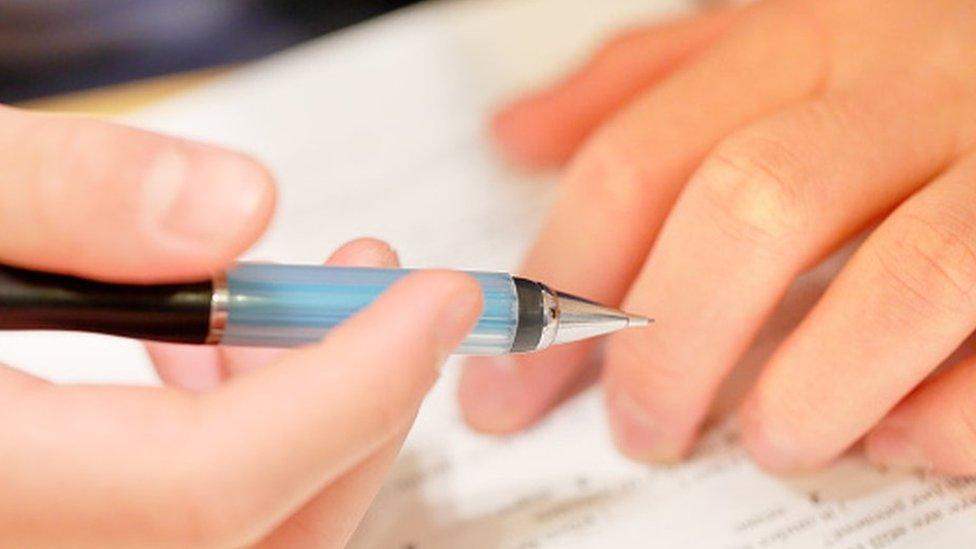All you need to know about secondary school league tables
- Published

As new-style secondary school league tables for England are published, the BBC News website takes you through the changes that are taking place this year.
How have the league tables changed?
Until this year, secondary school performance has been judged mainly by what proportion of pupils get five GCSEs at grade A*-C, including English and maths.
Instead two new measures, known as Attainment 8, external and Progress 8, external, have been adopted.
These will now be used by the government to judge whether schools are performing adequately.
Why have they been changed?
For many years, teachers and heads had complained that to judge a school by its results in five GCSEs alone was unfair, because it did not offer broader information about the ability of the pupils being taught.
Obviously if a high-achieving child comes to a school, it will not take as much effort to get them to a good GCSE grade as it would a lower-achieving child.
So schools which were working with more challenging pupils with low prior attainment were effectively marked down in the league tables, because this extra challenge was not considered.
There was also concern that the benchmark only assessed pupils who got results at grade C and above. The new measure takes into account achievement from grades A*-G.
Tap here to search for the results for your area.
What is Progress 8?
In basic terms, it aims to measure how well a school is serving its pupils by looking at where they started and where they end up.
It does this by looking at attainment in eight GCSE, or equivalent, subjects from grade A*-G for each pupil.
These results are then compared against the results of other pupils who came into secondary schools nationally with the same attainment levels.
A figure for those results across the school year group is then calculated. This result is then set within confidence levels, which set out how accurate the government believes the Progress 8 score is.
Progress 8 scores generally fall somewhere between -1 and 1.
The number (which is pretty abstract to all but the statisticians, as Progress 8 scores generally fall somewhere between -1 and 1) is then placed into one of five bands:
well above average
above average
average
below average
well below average.
It is these bandings which will be of most use to parents.
What is Attainment 8?
Attainment 8 is about the raw results across individual pupils' best eight subjects.
But they are not just any old subjects. English and maths are compulsory - and worth double points.
Then there is the choice of three subjects from the English Baccalaureate, external (core academic subjects), and any other three from the DfE's approved list of qualifications - including vocational qualifications.

The results are only recorded at the school level and an average score per pupil is calculated and published.
The maximum number of points per school is 80 points per pupil. The national average across all state secondary school is 49.9 this year.
Why the move to eight subjects?
The short answer is that it is thought to be fairer to see a pupil's best achievement across a broader spectrum of subjects.
Teachers and head teachers had complained that the five good GCSEs measure was too narrow.
They also argued that the more recently introduced English Baccalaureate was too prescriptive and only relevant for the more academic students.
If attainment across a broader range of subjects are be counted, then arts subjects and vocational qualifications count for something in school accountability as well.
Will parents be baffled by the new-look tables?
This has been a key concern, because the new measures are more complicated to read than the old tables based on five GCSE scores.
Progress 8 scores are far more abstract in that they generally fall somewhere between -1 and 1.
However, there are some figures in brackets below each score on the tables which measure how confident statisticians are that the figure above is accurate.

When the DfE trialled the new measures on panels of parents, many were confused by these scores and so the banded descriptions were introduced to aid understanding.
Secondary head teachers say that while is important for parents to look at a school's Progress 8 score, they should focus broadly on the descriptions such as "above average".
Parents may also wish to look at schools' Attainment 8 scores to have an overall idea of how they perform on GCSE results.
School performance measures are used just as much by officials to monitor standards and ultimately Progress 8 is an accountability measure.
A school is considered potentially failing if its Progress 8 score falls in the well below average band.
Are these changes happening elsewhere in the UK?
No, these new measures apply to England only.
However, there have been changes in terms of school accountability recently in Wales and Scotland.
Data on how well Scottish pupils do in reading, writing and numeracy was published for the first time, as part of a new Curriculum for Excellence.
The Welsh Assembly has recently reintroduced the publication of performance information, after abolishing it in 2001, in an attempt to raise standards.
Schools are now given a colour code - green, yellow, amber or red - according to how well they are performing.
School league tables are not published in Northern Ireland.
- Published19 January 2017
